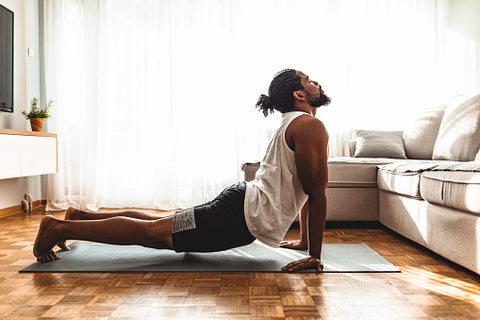Dealing with back pain is the worst. As a retired college athlete, I’ve been through it all. From wearing a back brace to using back cracker devices, I’ve tried countless pain relief methods.
What worked for me seemed unpopular and unconventional, but since learning and applying this philosophy, lower back pain has been a thing of the past in my life. If this resonates with your situation, you’re in luck. Learn how to combat lower back pain at home before spending half your paycheck at the doctor's office or PT clinic.

Disclaimer: I am not a doctor nor a licensed professional. I am somebody who has experienced back pain in many different ways. Temporarily and chronically, I’ve been through it all. I tried the chiropractic and PT route along with multiple doctors. The answer for me didn’t require surgery, nor months of physical therapy, it was surprisingly simple…
Before we get into my situation and 3-step plan, let’s dive into the origin of lower back pain.
Where does lower back pain come from?
Injuries from athletics are common. Straining or spraining surrounding spinal muscles can come in different forms such as improper lifting, repetitive movements, or overuse. A lot of people refer to this as a "thrown out back", especially if the pain originated from a high impact event.
On the more serious side:
Herniated or slipped discs (overstretching a muscle or tearing a ligament in your back)
Fracture vertebrae (break or crack in the spine)
If you believe your symptoms are on the more serious side, it’s important to see a medical professional.
Here are several different activities that could help pinpoint your pain origin.

Lower back pain when bending over
Why MY Lower Back Hurt So Bad
"The solution for your back pain may be simpler than you think. Many people are haunted by the fear that pinched nerves, ruptured disks, or arthritis is causing their back pain, when there’s a good chance that their pain may be coming solely, or at least in part, from myofascial trigger points in muscles. Even when back pain is due to genuine problems in the vertebral column, myofascial trigger points often contribute to a major part of the pain (Travell and Simons 1992)" [2].
What helped me not only cure years of back pain but also prevent it came from a combination of 3 steps…
Step 1: Trigger Points
Relieve lower back pain-inducing muscles from years of pent-up tension.
Inactive muscles surrounding the spine are crucial for pinpointing the origin of lower back pain. When certain muscles such as the quadratus lumborum, gluteus medius, and iliopsoas are left inactive or form trigger points, a larger burden of stress is placed on the spine, resulting in lower back pain.
How did I fix this?
There are different methods to eradicating trigger points but my personal favorite and what helped me the most was deep tissue massage.
Deep tissue massage applied to the Glutes, Psoas, and QL muscles can be done by the hands of a professional physical therapist (physio), chiropractor, or massage therapist, or at home with a purposefully made tool like QL Claw.


Muscle to attack:
Step 2: Stretching
After breaking down the tight muscle fibers with deep tissue massage, you are going to want to elongate the tissue with a proper stretch.
Improving the range of motion along with improved blood flow to the area will help reactive the muscle's purpose within the body.
13 stretches for lower back pain
Lower Back Flexibility Program

Step 3: Strengthening
Steps 1 and 2 are more in place for relieving pain, step 3 is intended for preventing future pain. Going through all the work to cure lower back pain just to have it resurface can be a vicious cycle, and let's be honest that’s no way to live.
3 Quadratus lumborum exercises for bulletproofing the low back
Gluteus medius exercises for lower back pain relief
Simple treatments and home remedies
If deep tissue massage isn’t your cup of tea, here are some things you can do to relieve pain and reduce inflammation at home. Depending on the severity of your pain, these simple relief tips can go a long way.
Hot and cold treatment
Focusing on posture (sitting posture, sleeping positions, turtle neck syndrome)

Stress relief
Active recovery - (walking, swimming, yoga, light mobility)
Pain relief cream - ( CBD cream is a popular treatment)
Increase sleep
FAQ:
When should I see a chiropractor for lower back pain?
The general rule of thumb is if you are in great pain and at home treatments are not working. Also, if you have reason to believe the issue originates from the spine or joints. Lower back pain is subjective which means this can be difficult to judge. A small amount of manageable pain is normal and can sometimes be dealt with at home, but listen to your body and make sure to meet with a professional if you are in great pain.
Why do rdls hurt my lower back?
Poor form is one of the most common reasons people experience lower back pain from RDLs. Going in cold and rushing the exercise is another common way people injure their lower backs from rdls. Lifting the weight off the ground in a jerking-type motion is never going to do your lower back any favors.
Why does my lower back hurt after squatting?
The first and most common reason you would be experiencing lower back pain after squats is due to poor squatting technique. Especially if you’re lifting more weight than your body can handle, there’s a good chance that your lower back is overcompensating. Rounding the back, overarching the spine, and leaning too far forward are all ways that squatting form could be causing you pain.
If your form is correct and you’re still experiencing pain, a common reason is a preexisting muscle injury or tightness. Common spinal surrounding areas include the quadratus lumborum, gluteus medius, piriformis, and iliopsoas.
Now that you've explored why your lower back hurts so bad, check out our page on how a back pain location chart works.
Sources:
[1] Donnelly, Joseph M. Travell, Simons & Simons Myofascial Pain and Dysfunction: the Trigger Point Manual. 3rd ed., Wolters Kluwer Health, 2019.
[2] Davies, Clair, and Amber Davies. The Trigger Point Therapy Workbook: Your Self-Treatment Guide for Pain Relief. 3rd ed., New Harbinger Publications, Inc., 2013.


